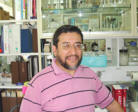| xxx | xxx | ||
|
|
|
||
|
|
Hoy es |
||
|
En Español |
Traducido por : Dr Fernando Enríquez-Rincón
|
||
|
Por favor, si desea dejarnos saber de dónde viene o si desea mostrarle a sus amigos este libro, pulse aquí INSTITUTO POLITÉCNICO NACIONAL
Centro de Investigación y de Estudios Avanzados del IPN |
Nuestra primera línea de defensa contra organismos extraños son las barreras de tejidos como la piel que impide la entrada de los organismos a nuestro cuerpo. Si, a pesar de esto, las barreras son penetradas, el cuerpo cuenta con células que responden rápidamente a la presencia del invasor. Estas células incluyen a los macrófagos y neutrófilos que ingieren a los organismos extraños y los matan sin necesidad de que existan anticuerpos previamente formados. Otro reto inmediato para los organismos invasores viene también de moléculas solubles que los privan de nutrientes esenciales (tales como el hierro) y de ciertas moléculas que se encuentran en la superficie de los epitelios, en secreciones (lágrimas y saliva) y en la circulación sanguínea. Esta forma de inmunidad corresponde al sistema innato o no-específico que se encuentra continuamente en estado de alerta para responder a la invasión. |
||
|
Logo image © Jeffrey Nelson, Rush University, Chicago, Illinois and The MicrobeLibrary |
|||
|
|
|||
|
DR FERNANDO ENRIQUEZ RINCON
|
En Español
CAPÍTULO UNO CAPÍTULO 2
CAPÍTULO TRES Antigens are substances that induce a specific immune response and subsequently react with the products of a specific immune response
|
||
|
|
EN INGLÉS
CHAPTER FOUR CHAPTER FIVE
CHAPTER SIX CHAPTER SEVEN ANTIBODY FORMATION Characteristics of the specific immune response - Primary and secondary antibody responses - The molecular events involved in class switching and membrane immunoglobulin expression |
||
|
En Español
CAPÍTULO NUEVE
|
|||
|
EN INGLÉS
CHAPTER TEN CHAPTER ELEVEN CHAPTER TWELVE IMMUNOREGULATION Subpopulations of helper T cells: Th1 and Th2. Cytokines and class (isotype) switching. Cytokine activation of macrophages and functions. Maturation and mechanism of killing by cytolytic T lymphocytes (CTL). Characteristics of killing mechanisms of other cytolytic cells Immunoregulatory processes
CHAPTER FOURTEEN CHAPTER FIFTEEN CHAPTER SIXTEEN CHAPTER SEVENTEEN TUMOR IMMUNOLOGY Evidence for immune reactivity to tumor. Changes in cellular characteristics due to malignancy.Host components which affect tumor progression. Tumor cell components which protect it from the immune system.Rationale for tumor immunotherapy and know the approaches
CHAPTER NINETEEN
|
|||
|
Loading
|
|||
|
En Español
|


